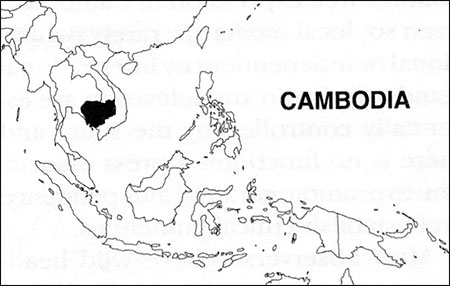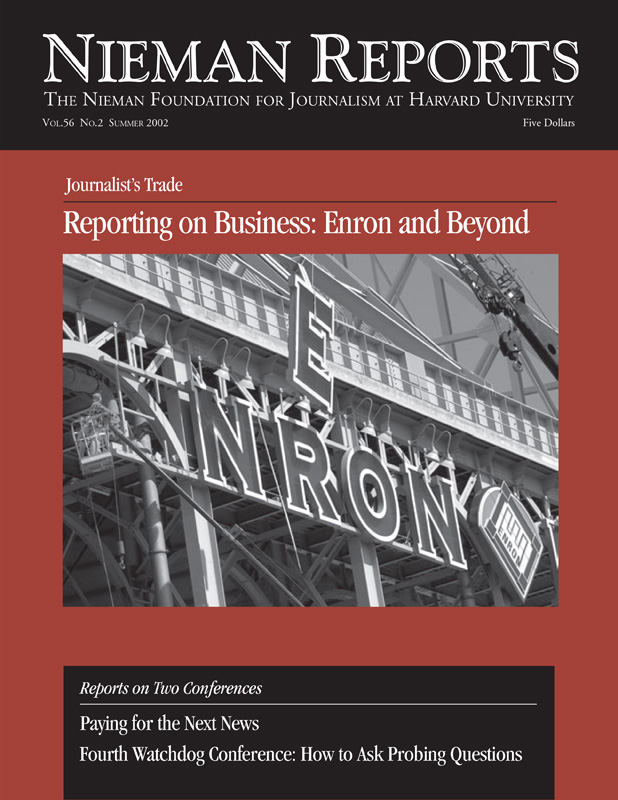
During the last two years Cambodia’s 20-year nightmare of violence, spawned by the spillover of the Vietnam War, has largely abated. Reporting from Phnom Penh on Cambodia’s newfound political stability, The New York Times reporter Seth Mydans noted that “many people here see glimmers of hope as the government—both aided and pressured by foreign donors—begins to lay the groundwork for change. An active and liberal civil society has begun to take root, a functioning government administration is being mapped out, and the traumas of the past are beginning to be tentatively addressed.”
The Cambodian press has suffered its share of traumas. As part of their genocidal campaign to impose radical agrarian socialism on Cambodia, the Khmer Rouge killed most of the country’s intellectuals between 1975 and 1979, including almost all journalists. In 1995, the president of the Khmer Journalists Association said that he knew of only 10 living Cambodian journalists who had worked as journalists before 1975, the year Pol Pot seized power. The Cambodian press today may not be particularly responsible, but it is lively and largely fearless. Given the recent history of Cambodia, this is an achievement in itself.
After a Vietnamese invasion ousted Pol Pot in 1979, the country struggled through 12 years of civil war and Leninist rule under the communist regime of Hun Sen. The 1991 Paris Peace Accords mandated that the international community should oversee Cambodia’s transition from a totalitarian to a more democratic society. These accords gave the United Nations Transitional Authority in Cambodia (UNTAC) a broad mandate that included keeping the peace and administering democratic elections in 1993. To date, this transition has been rough and incomplete.
Starved for talent after years of civil war and emerging from the shadows of one of history’s darkest regimes, Cambodia’s press was in dire straits in 1991. The few practicing journalists had either worked for state-owned media under the strict guidance of the Communist government, or been part of the partisan opposition press, much of it based abroad or in refugee camps along the Thai border and backing various armed factions opposed to Hue Sen’s Cambodian People’s Party (CPP).
Pnomh Penh boasts a number of printing presses now, but in 1991 there was no media infrastructure. Newspapers had to be printed in Thailand and shipped into Phnom Penh. And a communist culture of control had to be reformed almost overnight with few guidelines beyond the 1993 Constitution’s U.N.-imposed press freedom provision. At the end of 1993, U.N.-sponsored elections also brought Prince Norodom Ranariddh’s National United Front for an Independent, Neutral, Peaceful and Cooperative Cambodia (FUNCINPEC) to power in an uneasy coalition with Hun Sen, who served as second prime minister under Ranariddh.
In July 1997, Hun Sen ousted Ranariddh in a coup, thus negating the results of the 1993 election. After the coup, dozens of pro-opposition journalists fled the country. At the same time, Cambodia’s most widely recognized press organization, the Khmer Journalists Association, effectively ceased to exist when its chairman, Pin Samkhon, went into exile. That year also saw the pullout of the UNTAC from Cambodia.
Somewhat paradoxically, UNTAC was also supposed to establish a free press. Since 1991, the international community has spent millions of dollars to train local journalists and encourage free expression in Cambodia. Even so, local media are rarely professional or independent by international standards. Radio and television are essentially controlled by the state, and there is no functioning press association to promote editorial independence and establish ethical guidelines.
Most observers believe wild headlines and stories without attributed sources contributed to the political tension that nearly plunged Cambodia back into the darkness of its political past, especially during the Ranariddh/Hun Sen coalition period from 1993 to 1997. “Ranariddh Is Three Times as Stupid as Hun Sen Twice a Day,” blared one headline a few years ago. “Don’t Invest in Cambodia Because Hun Sen Is the Biggest Thief,” read another headline from the same period. To this day, pro-opposition papers routinely describe CPP politicians as crooks and tools of the Vietnamese, while pro-CPP papers accuse opposition leaders of being stupid and corrupt.
But inept Cambodian reporters are not to blame for the broader problem of impunity in a country where corrupt courts and judges allow many crimes to go unpunished. Although the 1993 Constitution guarantees press freedom, no one has ever been prosecuted for killing a journalist in Cambodia, and many reporters live in fear of being attacked for what they write. In 1994, unknown gunmen killed Nun Chan, the editor of Samlong Yuvachon Khmer, after government officials made a series of public threats against him. In 1995, the paper was suspended for several weeks and its new editor arrested after he published articles critical of Second Prime Minister Hun Sen. Since then, four more journalists have been killed in Cambodia. Many others have survived violent attacks, and several newspapers have been closed by state fiat.
Cambodian newspapers may not be particularly responsible, but they are largely free of government control to a degree rarely seen in Southeast Asia. Freedom for the print media, though, is due in large part to international pressure, which has not had a similar impact on radio or television. Broadcast media remain under firm state control.
The Hun Sen government exercises formal and informal control over electronic media by withholding licenses from its opponents and granting them to its allies. With the exception of one very low-power radio station in Pnomh Penh run by the Women’s Media Center and businessman Mam Sonando’s iconoclastic “Radio Beehive,” Cambodia’s airwaves are essentially run either by the government or its allies. Meanwhile, the Sam Rainsy Party, the principal opposition voice in Cambodia, has repeatedly been denied permission to open a radio station. The country’s six television stations once carried innovative public affairs programming, including one program on state TV that allowed callers to question government ministers on the air. That show was cancelled in 1995. Today, self-censorship is widely practiced.
This electronic vacuum is partly filled by Khmer-language short-wave broadcasts from the BBC and the Washington-based, U.S. government-funded Voice of America and Radio Free Asia. While the Hun Sen government has been more tolerant of such broadcasting than neighboring Vietnam and Laos, there are limits to its patience. Earlier this year, for example, the Ministry of Information abruptly cancelled a deal that would have given Radio Free Asia an FM transmitter site in Cambodia.
The Cambodian press is deeply politicized because most newspapers depend on the patronage of political actors for their survival. “No Khmer [-language] paper makes money, so everything is subsidized by somebody,” says Michael Hayes, the American publisher of the biweekly, English-language Phnom Penh Post. There are 200 licensed publications in the country and some 30 newspapers that publish regularly in Phnom Penh. But only a few papers raise significant sums from advertising. Norbert Klein of Open Forum Cambodia, an NGO that monitors the local press, estimates that 99 percent of local advertising revenue goes to just 10 newspapers. Rasmei Kampuchea alone accounts for 23 percent of the Cambodian newspaper industry’s total ad sales.
Rasmei Kampuchea was launched in 1993 as a joint venture between a Thai media group and Theng Bun Ma, a powerful businessman and Hun Sen ally. By the time the Asian economic crisis forced the Thais to give up their investment in 1997, the paper was strong enough to continue on its own. While Rasmei remains pro-government, it is arguably the closest thing Cambodia has to a balanced Khmer-language broadsheet. Its editor, Pen Samithy, is credited with trying to train a professional newsroom staff. Samithy freely acknowledges his personal links to the old CPP (he was trained in journalism in Moscow in the 1980’s). But he also claims that he is now free to criticize the CPP and that he has done so in print.
By all accounts, the general standard of Cambodian journalism has improved in recent years, although reading the morning paper can still be a hair-raising experience. Several Khmer-language newspapers have openly accused Hun Sen’s wife of being a former prostitute and a murderer. Recently, a Cambodian paper ran a so-called investigative story that falsely accused Vietnam and Thailand of supplying Cambodia’s anti-AIDS program with HIV-impregnated condoms.
Despite progress in the Khmer-language press, it is two foreign-owned, English-language publications, the Cambodia Daily and the Phnom Penh Post, which continue to serve as de facto newspapers of record and training grounds for Khmer journalists. Both papers maintain high editorial standards, print a few pages in Khmer, and employ a handful of local journalists. They are relics of a more optimistic era, when foreign companies thought there was money to be made in Cambodian media, but their persistence has been crucial in providing a source of fair-minded reporting in a politically charged environment.
After the death of Pol Pot in late 1998, the Khmer Rouge collapsed. As a result, Cambodia is at peace for the first time in more than 30 years, and that fact alone gives local journalists ground for hope. “I hope the peace lasts,” says Ker Munthit, a leading Cambodian reporter who works for The Associated Press in Phnom Penh. “I am so tired of reporting on the Khmer Rouge.”
Several months after the disputed elections of July 1998, Prime Minister Hun Sen formed a coalition government that allowed him to consolidate the power he had seized in the 1997 coup. Prince Ranariddh, currently president of the National Assembly and a potential successor to the throne of his ailing father, King Norodom Sihanouk, has reached a personal compromise with Hun Sen. As a result, the media proxy fights of the recent past have died down.
Given the strides made in expanding free expression in Indonesia and Thailand in recent years, the Cambodian government’s restrictive media policies seem increasingly anachronistic. The regional Southeast Asian Press Alliance (SEAPA), which includes press organizations from Thailand, the Philippines, and Indonesia, has opened informal discussions with Khmer journalists aimed at assisting in the development of an independent press association. And a new weekly newspaper, Sakarach Thmei, has drawn attention for its attempts to maintain a politically independent editorial line. “We have to have an independent press,” says Ham Hak, the paper’s young editor.
A. Lin Neumann is a consultant on Asian issues to the Committee to Protect Journalists (CPJ) based in Bangkok. He has covered Asia as a journalist for 20 years. This article is excerpted from a report originally prepared for CPJ (www.cpj.org).


